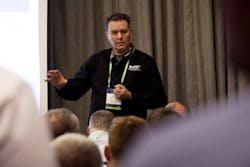System Platform 2017 Roadmap
Schneider Electric announced a major leap in its development architecture with the roll out of System Platform 2017 in June. The next-generation platform includes native visualization—replacing InTouch for System Platform—and tighter integration with the Schneider Electric Industrial Software Platform.
On the back end, it digitally links engineering, operations and asset performance aspects, enabling developers to build re-usable industrial applications and content with practically no customization or scripting. A unified visualization client, InTouch Operations Management Interface (OMI), includes a responsive design that can graphically render on different devices without any application re-engineering or coding.
The platform is a common information model that brings context to real-time processes, alarms, events and historical data archived across disparate business systems, making design and maintenance more efficient, flexible and secure.
“System Platform 2017 is an end-to-end industrial automation platform and is the foundation for IT and OT convergence,” said Rob Kambach, Product Manager for System Platform & InTouch OMI at Schneider Electric. The latest version has redefined how standards are built via object wizards, while visualization moves from a tag-based system to object models, providing structure from the start.
“Build it once and build it for all,” Kambach said during a presentation at Schneider Electric’s Innovation Summit: Software Conference 2017, this week. Applications can look back into historians without requiring any configuration. “Our idea around apps is that there is nothing you have to do to integrate these systems. It is done for you,” Kambach said.
Even with the major revamp just a few months ago, Kambach outlined some new functionality in the first System Platform 2017 update, which will come out this month. First, it will have everything needed for a production environment, Kambach said. Another big thing will be the addition of an HTML5 mapping app and dynamic asset links that brings device attributes into the graphic.
In future updates, there is a lot of focus on the user experience and situational awareness. The interface is 80 percent Google Design and 20 percent Schneider Electric. It has new editors, including a layout editor (how and where you want to display) and a ViewApp Editor (what you want to display). An Object Library (of equipment, instruments, valve assets, etc.) include pre-built standards to help a not-so-savvy developer add something to the ViewApp.
To that end, the company envisions three new types of users—which Schneider Electric refer to by name:
Richard: Standards Developer (develops standards for visualization and objects)
Evan: Application Assembler (strong domain knowledge)
Ray: Technician (strong process knowledge and understanding of equipment)
“To make Ray a fan, we have an asset library of pre-built standards for any PLC, DCS or PAC,” Kambach said. “One object library covers 80 percent of the automation needs.” Ray just edits the screen, searches for a new flowmeter, for example, which brings up a template in the system, and then he can drag and drop it onto the screen. “It empowers the end user to add something simple to the system. Would you build whole system this way? No. But it can be used for doing ad hoc work.”
There are many more features rolling out, including historic playback, alarm aggregation enhancements and different navigation models for different users. But the takeaway for the future of System Platform is the ability to have “context at the core.”

